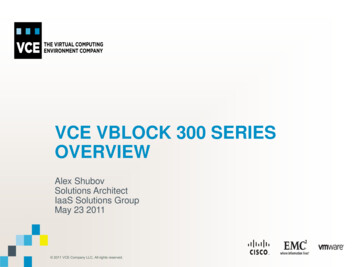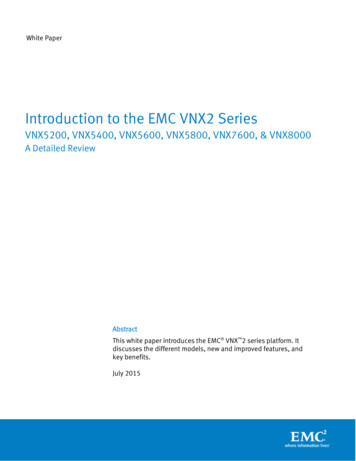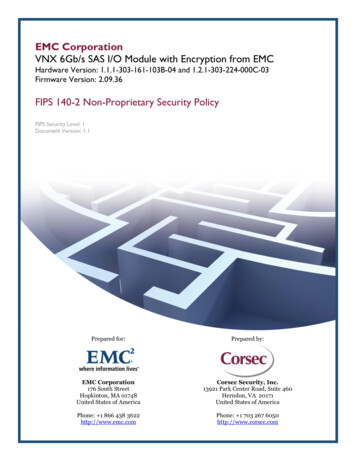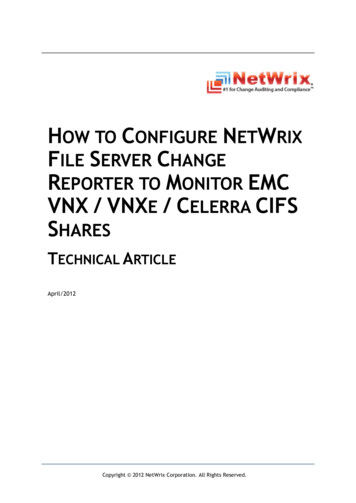
Transcription
Monitoring Dell EMC VNXEMC: VNX PowerPack version 101
Table of ContentsIntroductionWhat is Dell EMC VNX?What Does the EMC: VNX PowerPack Monitor?Installing the EMC: VNX PowerPackMonitoring Dell EMC VNX Storage SystemsPrerequisitesCreating a Credential for Dell EMC VNXDiscovering Dell EMC VNX DevicesManually Aligning Dynamic ApplicationsViewing Dell EMC VNX DevicesRelationships with Other Types of Component DevicesAvailable Metrics for Dell EMC VNX Component DevicesDell EMC VNX Device DashboardsDevice DashboardsEMC VNX RAID Group LUNEMC VNX Storage Pool LUNEMC VNX RAID GroupEMC VNX Storage PoolEMC VNX Storage Processor DashboardEMC VNX Storage System Dashboard33446678101215151717181920212223
Chapter1IntroductionOverviewThis manual describes how to monitor Dell EMC VNX devices in the ScienceLogic platform using the EMC:VNX PowerPack.The following sections provide an overview of Dell EMC VNX and the EMC: VNX PowerPack:What is Dell EMC VNX?3What Does the EMC: VNX PowerPack Monitor?4Installing the EMC: VNX PowerPack4NOTE: ScienceLogic provides this documentation for the convenience of ScienceLogic customers. Some ofthe configuration information contained herein pertains to third-party vendor software that is subject tochange without notice to ScienceLogic. ScienceLogic makes every attempt to maintain accuratetechnical information and cannot be held responsible for defects or changes in third-party vendorsoftware. There is no written or implied guarantee that information contained herein will work for allthird-party variants. See the End User License Agreement (EULA) for more information.What is Dell EMC VNX?The Dell EMC VNX series is a family of unified hybrid flash storage arrays that combine block-based and file-basedstorage solutions in a single platform. VNX arrays use the EMC SMI-S Provider open storage managementinterface.Introduction31
What Does the EMC: VNX PowerPack Monitor?To monitor Dell EMC VNX systems using the ScienceLogic platform, you must install the EMC: VNX PowerPack,which enables you to discover, model, and collect data about VNX storage arrays and file systems.NOTE: The EMC: VNX PowerPack requires EMC SMI-S Provider version 4.6.2 and higher, but less thanversion 8.0.NOTE: Monitoring VNX file systems is optional. If you choose to monitor file systems in addition to storagearrays, you must run a second discovery session to discover and model the file systems. For moreinformation, see the section on Discovering Dell EMC VNX Devices.The EMC: VNX PowerPack includes:lAn example credential you can use to create Basic/Snippet credentials to connect to Dell EMC VNX deviceslDynamic Applications to discover and monitor VNX deviceslDevice Classes for each type of VNX device monitored by the ScienceLogic platformllEvent Policies and corresponding alerts that are triggered when VNX devices exceed thresholds for file systemutilization.Dashboards that present summary information for VNX component devicesInstalling the EMC: VNX PowerPackBefore completing the steps in this manual, you must import and install the latest version of the EMC:VNX PowerPack.To download and install a PowerPack:TIP: By default, installing a new version of a PowerPack overwrites all content in that PowerPack that hasalready been installed on the target system. You can use the Enable Selective PowerPack FieldProtection setting in the Behavior Settings page (System Settings Behavior) to prevent newPowerPacks from overwriting local changes for some commonly customized fields. (For more information,see the System Administration manual.)1. Download the PowerPack from the ScienceLogic Customer Portal.2. Go to the PowerPack Manager page (System Manage PowerPacks).3. In the PowerPack Manager page, click the [Actions] button, then select Import PowerPack.4Introduction
4. The Import PowerPack dialog box appears:15. Click the [Browse] button and navigate to the PowerPack file.6. When the PowerPack Installer modal page appears, click the [Install] button to install the PowerPack.NOTE: If you exit the PowerPack Installer modal page without installing the imported PowerPack, theimported PowerPack will not appear in the PowerPack Manager page. However, the importedPowerPack will appear in the Imported PowerPacks modal page. This page appears when you clickthe [Actions] menu and select Install PowerPack.Introduction5
Chapter2Monitoring Dell EMC VNX Storage SystemsOverviewThe following sections describe how to configure and discover Dell EMC VNX systems for monitoring by theScienceLogic platform using the EMC: VNX PowerPack:Prerequisites6Creating a Credential for Dell EMC VNX7Discovering Dell EMC VNX Devices8Manually Aligning Dynamic ApplicationsViewing Dell EMC VNX DevicesRelationships with Other Types of Component DevicesAvailable Metrics for Dell EMC VNX Component Devices10121515PrerequisitesBefore you can monitor Dell EMC VNX storage systems using the EMC: VNX PowerPack, you must have thefollowing information about an EMC SMI-S Provider that has already been properly installed and configured:lUsername and password for a user with access to the SMI-S ProviderlIP address and port for the SMI-S ProviderAdditionally, statistics logging must be enabled on each Dell EMC VNX storage system that will be monitored. Todo so:1. Log in to Unisphere.Monitoring Dell EMC VNX Storage Systems62
2. Select a Dell EMC VNX storage array from the list, and then click the [System] tab.3. In the System Management menu, click System Properties.4. On the Storage System Properties dialog box, click the [General] tab.5. Select the Statistics Logging checkbox, and then click [OK].Creating a Credential for Dell EMC VNXTo configure the ScienceLogic platform to monitor Dell EMC VNX systems, you must first create a Basic/Snippetcredential. This credential allows the Dynamic Applications in the EMC: VNX PowerPack to connect with anEMC SMI-S Provider. An example Basic/Snippet credential that you can edit for your own use is included in theEMC: VNX PowerPack.To create a Basic/Snippet credential to access an EMC SMI-S Provider:1. Go to the Credential Management page (System Manage Credentials).2. Locate the EMC SMI-S Example credential, and then click its wrench icon (Credential modal page appears.). The Edit Basic/Snippet3. Enter values in the following fields:lCredential Name. Type a new name for the Dell EMC VNX credential.lHostname/IP. Type the IP address of the SMI-S Provider.lPort. Type "5988" for an HTTP connection or "5989" for an HTTPS connection.lTimeout. Type "30".lUsername. Type the username for a user with access to the SMI-S Provider.lPassword. Type the password for the SMI-S Provider account username.4. Click the [Save As] button.5. When the confirmation message appears, click [OK].7Monitoring Dell EMC VNX Storage Systems
NOTE: To monitor VNX arrays and file systems that have different login credentials, create a separateBasic/Snippet credential for each.Discovering Dell EMC VNX Devices2To model and monitor your Dell EMC VNX system, you must run a discovery session to discover the EMC SMI-SProvider that the platform will use as the root device for monitoring the VNX system.The discovery session will discover the SMI-S Provider as a pingable device using the Basic/Snippet credentialthat you created. Several minutes after the discovery session has completed, the Dynamic Applications in theEMC: VNX PowerPack should automatically align to the SMI-S Provider root device to discover, model, andmonitor the remaining component devices in your VNX system.To discover the SMI-S Provider for the Dell EMC VNX system that you want to monitor, perform the following steps:1. Go to the Discovery Control Panel page (System Manage Discovery).2. In the Discovery Control Panel, click the [Create] button.Monitoring Dell EMC VNX Storage Systems8
3. The Discovery Session Editor page appears. In the Discovery Session Editor page, define values in thefollowing fields:lIP Address Discovery List. Enter the IP address for the SMI-S Provider.lSNMP Credentials. Do not select any credentials in this field.lOther Credentials. Select the Basic/Snippet credential you created for the SMI-S Provider.lInitial Scan Level. Select 5. Deep Discovery. The EMC: VNX PowerPack includes non-SNMP deviceclasses that are aligned only during deep discovery. If you do not select 5. Deep Discovery in this field,the SMI-S Provider will be discovered and assigned a device class for a pingable device.lDiscover Non-SNMP. You must select this checkbox.lModel Devices. You must select this checkbox.4. Optionally, you can enter values in the other fields on this page. For more information about the other fieldson this page, see the Discovery & Credentials manual.5. Click the [Save] button to save the discovery session and then close the Discovery Session Editor window.6. The discovery session you created will display at the top of the Discovery Control Panel page. Click itslightning-bolt icon () to run the discovery session.7. The Discovery Session window will appear. When the SMI-S Provider is discovered, click its device icon () to view the Device Properties page for the SMI-S Provider.9Monitoring Dell EMC VNX Storage Systems
NOTE: To monitor VNX storage arrays and file systems that have different IP addresses and/or credentials,create and run a separate discovery session for each.Manually Aligning Dynamic Applications2NOTE: It can take several minutes after discovery for Dynamic Applications to display on the DynamicApplication Collections page. If the listed Dynamic Applications do not display on this page, tryclicking the [Reset] button.To verify that the ScienceLogic platform has automatically aligned the correct Dynamic Applications duringdiscovery:1. From the Device Properties page (Registry Devices wrench icon()) for the SMI-S Provider, click the[Collections] tab. The Dynamic Application Collections page appears.Monitoring Dell EMC VNX Storage Systems10
2. If the SMI-S Provider that you are monitoring is a storage area network (SAN) device, then the followingDynamic Applications should display in the list of aligned Dynamic Applications:lEMC: VNX Array DiscoverylEMC: VNX Components ConfigurationlEMC: VNX LUN CacheIf the SMI-S Provider that you are monitoring is a network-attached storage (NAS) device, then the followingDynamic Application should display in the list of aligned Dynamic Applications:lEMC: VNX File DiscoveryIf the listed Dynamic Applications have not been automatically aligned, you can align them manually. To do so,perform the following steps:1. For the "EMC: VNX Array Discovery" Dynamic Application, click the [Action] button on the DynamicApplication Collections page of the SMI-S Provider device and then select Add Dynamic Application fromthe menu. The Dynamic Application Alignment page appears.2. In the Dynamic Applications field, select EMC: VNX Array Discovery.3. In the Credentials field, select the Basic/Snippet credential you configured for the SMI-S Provider.4. Click the [Save] button.5. Repeat steps 1–4 for the other Dynamic Applications, as needed.11Monitoring Dell EMC VNX Storage Systems
6. After aligning the Dynamic Applications, click the [Reset] button and then click the plus icon ( ) for theDynamic Applications. If collection for the Dynamic Applications was successful, the graph icons (Dynamic Applications are enabled.) for the7. Click the graph icon () for the "EMC: VNX Components Configuration" Dynamic Application to view thecollected data. The Configuration Report page will display the number of components of each type and thetotal number of components managed by the device.2Viewing Dell EMC VNX DevicesWhen the ScienceLogic platform discovers your Dell EMC VNX system, the platform will create component devicesthat represent each component in your VNX system.NOTE: Dell EMC VNX storage pools are identified by the pool name. If a storage pool is renamed, a newcomponent device will be created and the old component device will remain until it is vanished orpurged.NOTE: Dell EMC VNX storage arrays and file systems use different root IP addresses. Therefore, if you aremonitoring both arrays and file systems, each will have its own set of component views on the DeviceView, Device Components, and Device Component Map pages.Monitoring Dell EMC VNX Storage Systems12
In addition to the Device Manager page, you can view the VNX system and all associated component devices inthe following places in the user interface:l13The Device View modal page (click the bar-graph icon []for a device, then click the Topology tab)displays a map of the selected device and all of the devices with which it has parent-child relationships.Double-clicking any of the devices listed reloads the page to make the selected device the primary device:Monitoring Dell EMC VNX Storage Systems
lThe Device Components page (Registry Devices Device Components) displays a list of all root devicesand component devices discovered by the ScienceLogic platform in an indented view, so you can easily viewthe hierarchy and relationships between child devices, parent devices, and root devices. To view thecomponent devices associated with your VNX system, find the SMI-S Provider and click its plus icon ( ):2lThe Device Component Map page (Views Device Maps Components) allows you to view devices byroot node and view the relationships between root nodes, parent components, and child components in amap. This makes it easy to visualize and manage root nodes and their components. The ScienceLogicplatform automatically updates the Device Component Map page as new component devices arediscovered. The platform also updates each map with the latest status and event information. To view themap for your VNX system, go to the Device Component Map page and select the map from the list in theleft NavBar. To learn more about the Device Component Map page, see the Views manual.Monitoring Dell EMC VNX Storage Systems14
Relationships with Other Types of Component DevicesThe ScienceLogic platform can automatically build relationships between Dell EMC VNX component devices andother associated devices. If you discover a vCenter device using the Dynamic Applications in the VMware:vSphere Base Pack PowerPack and/or a UCS device using the Dynamic Applications in the Cisco:UCS PowerPack, the platform will automatically create relationships between the following types of componentdevices, where appropriate:lDell EMC VNX LUNs and VMware DatastoreslDell EMC VNX LUNs and UCS Service ProfilesAvailable Metrics for Dell EMC VNX Component DevicesThe EMC SMI-S provider does not expose all metrics for every type of Dell EMC VNX device. Because of this, somemetrics are not available on all VNX component devices in the ScienceLogic platform. The following tableindicates the available metrics on each type of VNX component device.VNXStorageSystemCapacity TotalVNXStorageProcessorXCapacity UsedCapacity XXXXXVNXStoragePool LUNVNXRAID GroupLUNCache ReadHitsXCache WriteHitsXCache ReadHit RatioXCache WriteHit nIO Total15XXXXXXXXMonitoring Dell EMC VNX Storage Systems
NXRAIDGroupVNXSnapViewPoolVNXStoragePool LUNVNXRAID GroupLUNIO ReadXXXXIO WriteXXXXXXXXLUN UtilizationPort IOXPortThroughputXService tWriteXXXXMonitoring Dell EMC VNX Storage Systems216
Chapter3Dell EMC VNX Device Dashboards3OverviewThe following sections describe the device dashboards that are included in the EMC: VNX PowerPack:Device Dashboards17EMC VNX RAID Group LUN18EMC VNX Storage Pool LUN19EMC VNX RAID Group20EMC VNX Storage Pool21EMC VNX Storage Processor Dashboard22EMC VNX Storage System Dashboard23Device DashboardsThe EMC: VNX PowerPack includes device dashboards that provide summary information for VNX componentdevices. Each of the device dashboards in the EMC: VNX PowerPack are set as the default device dashboard forthe equivalent device class.Dell EMC VNX Device Dashboards17
EMC VNX RAID Group LUNThe EMC VNX RAID Group LUN device dashboard displays the following information:18lInput/output operations over a specified period of timelService time over a specified period of timelCache hit ratio over a specified period of timelDevice logsDell EMC VNX Device Dashboards
EMC VNX Storage Pool LUN3The EMC VNX Storage Pool LUN device dashboard displays the following information:lInput/output operations over a specified period of timelService time over a specified period of timelLUN utilization over a specified period of timelDevice logsDell EMC VNX Device Dashboards19
EMC VNX RAID GroupThe EMC VNX RAID Group device dashboard displays the following information:20lA topology map displaying the component device and its parent-child relationshipslCurrent utilization of usable capacitylUsable capacity over the past 30-day periodlDevice logsDell EMC VNX Device Dashboards
EMC VNX Storage Pool3The EMC VNX Storage Pool device dashboard displays the following information:lA topology map displaying the component device and its parent-child relationshipslCurrent utilization of usable capacitylUsable capacity over the past 30-day periodlDevice logsDell EMC VNX Device Dashboards21
EMC VNX Storage Processor DashboardThe EMC VNX Storage Processor device dashboard displays the following information:22lInput/output operations over a specified period of timelTop 10 fibre channel ports for input/output trafficlTop 10 iSCSI ports for input/output trafficlDevice logsDell EMC VNX Device Dashboards
EMC VNX Storage System Dashboard3The EMC VNX Storage System device dashboard displays the following information:lInput/output operations over a specified period of timelCurrent utilization of raw capacity for the arraylCurrent raw storage capacity for the arraylDevice logsDell EMC VNX Device Dashboards23
2003 - 2017, ScienceLogic, Inc.All rights reserved.LIMITATION OF LIABILITY AND GENERAL DISCLAIMERALL INFORMATION AVAILABLE IN THIS GUIDE IS PROVIDED "AS IS," WITHOUT WARRANTY OF ANYKIND, EITHER EXPRESS OR IMPLIED. SCIENCELOGIC AND ITS SUPPLIERS DISCLAIM ALL WARRANTIES,EXPRESS OR IMPLIED, INCLUDING, BUT NOT LIMITED TO, THE IMPLIED WARRANTIES OFMERCHANTABILITY, FITNESS FOR A PARTICULAR PURPOSE OR NON-INFRINGEMENT.Although ScienceLogic has attempted to provide accurate information on this Site, information on this Sitemay contain inadvertent technical inaccuracies or typographical errors, and ScienceLogic assumes noresponsibility for the accuracy of the information. Information may be changed or updated without notice.ScienceLogic may also make improvements and / or changes in the products or services described in thisSite at any time without notice.Copyrights and TrademarksScienceLogic, the ScienceLogic logo, and EM7 are trademarks of ScienceLogic, Inc. in the United States,other countries, or both.Below is a list of trademarks and service marks that should be credited to ScienceLogic, Inc. The and symbols reflect the trademark registration status in the U.S. Patent and Trademark Office and may not beappropriate for materials to be distributed outside the United States.lllllScienceLogic EM7 and em7 Simplify IT Dynamic Application Relational Infrastructure Management The absence of a product or service name, slogan or logo from this list does not constitute a waiver ofScienceLogic’s trademark or other intellectual property rights concerning that name, slogan, or logo.Please note that laws concerning use of trademarks or product names vary by country. Always consult alocal attorney for additional guidance.OtherIf any provision of this agreement shall be unlawful, void, or for any reason unenforceable, then thatprovision shall be deemed severable from this agreement and shall not affect the validity and enforceabilityof any remaining provisions. This is the entire agreement between the parties relating to the matterscontained herein.In the U.S. and other jurisdictions, trademark owners have a duty to police the use of their marks. Therefore,if you become aware of any improper use of ScienceLogic Trademarks, including infringement orcounterfeiting by third parties, report them to Science Logic’s legal department immediately. Report as muchdetail as possible about the misuse, including the name of the party, contact information, and copies orphotographs of the potential misuse to: legal@sciencelogic.com
800-SCI-LOGIC (1-800-724-5644)International: 1-703-354-1010
4 WhatDoestheEMC:VNX PowerPackMonitor? TomonitorDellEMC VNX theEMC:VNX PowerPack, whichenablesyoutodiscover,model .










